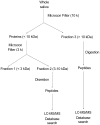Comparative salivary proteome of hepatitis B- and C-infected patients
- PMID: 25423034
- PMCID: PMC4244100
- DOI: 10.1371/journal.pone.0113683
Comparative salivary proteome of hepatitis B- and C-infected patients
Abstract
Hepatitis B and C virus (HBV and HCV) infections are an important cause of cirrhosis and hepatocellular carcinoma. The natural history has a prominent latent phase, and infected patients may remain undiagnosed; this situation may lead to the continuing spread of these infections in the community. Compelling reasons exist for using saliva as a diagnostic fluid because it meets the demands of being an inexpensive, noninvasive and easy-to-use diagnostic method. Indeed, comparative analysis of the salivary proteome using mass spectrometry is a promising new strategy for identifying biomarkers. Our goal is to apply an Orbitrap-based quantitative approach to explore the salivary proteome profile in HBV- and HCV-infected patients. In the present study, whole saliva was obtained from 20 healthy, (control) 20 HBV-infected and 20 HCV-infected subjects. Two distinct pools containing saliva from 10 subjects of each group were obtained. The samples were ultracentrifuged and fractionated, and all fractions were hydrolyzed (trypsin) and injected into an LTQ-VELOS ORBITRAP. The identification and analyses of peptides were performed using Proteome Discoverer1.3 and ScaffoldQ + v.3.3.1. From a total of 362 distinct proteins identified, 344 proteins were identified in the HBV, 326 in the HCV and 303 in the control groups. Some blood proteins, such as flavin reductase (which converts biliverdin to bilirubin), were detected only in the HCV group. The data showed a reduced presence of complement C3, ceruloplasmin, alpha(1)-acid glycoprotein and alpha(2)-acid glycoprotein in the hepatitis-infected patients. Peptides of serotransferrin and haptoglobin were less detected in the HCV group. This study provides an integrated perspective of the salivary proteome, which should be further explored in future studies targeting specific disease markers for HBV and HCV infection.
Conflict of interest statement
Figures


Similar articles
-
Analysis of protein interaction networks for the detection of candidate hepatitis B and C biomarkers.IEEE J Biomed Health Inform. 2015 Jan;19(1):181-9. doi: 10.1109/JBHI.2014.2344732. Epub 2014 Jul 31. IEEE J Biomed Health Inform. 2015. PMID: 25099894
-
Persistent Replication of HIV, Hepatitis C Virus (HCV), and HBV Results in Distinct Gene Expression Profiles by Human NK Cells.J Virol. 2019 Apr 17;93(9):e00575-18. doi: 10.1128/JVI.00575-18. Print 2019 May 1. J Virol. 2019. PMID: 30185599 Free PMC article.
-
MicroRNA 130a Regulates both Hepatitis C Virus and Hepatitis B Virus Replication through a Central Metabolic Pathway.J Virol. 2018 Mar 14;92(7):e02009-17. doi: 10.1128/JVI.02009-17. Print 2018 Apr 1. J Virol. 2018. PMID: 29321333 Free PMC article.
-
Regulatory mechanisms of viral hepatitis B and C.J Biosci. 2003 Apr;28(3):311-21. doi: 10.1007/BF02970150. J Biosci. 2003. PMID: 12734409 Review.
-
Coinfection of Schistosoma Species with Hepatitis B or Hepatitis C Viruses.Adv Parasitol. 2016;91:111-231. doi: 10.1016/bs.apar.2015.12.003. Epub 2016 Feb 5. Adv Parasitol. 2016. PMID: 27015949 Review.
Cited by
-
Differentially expressed serum host proteins in hepatitis B and C viral infections.Virusdisease. 2018 Dec;29(4):468-477. doi: 10.1007/s13337-018-0484-y. Epub 2018 Sep 1. Virusdisease. 2018. PMID: 30539049 Free PMC article.
-
Saliva proteomics updates in biomedicine.J Biol Res (Thessalon). 2019 Dec 12;26:17. doi: 10.1186/s40709-019-0109-7. eCollection 2019 Dec. J Biol Res (Thessalon). 2019. PMID: 31890650 Free PMC article. Review.
-
Metabolomics analysis of the saliva in patients with chronic hepatitis B using nuclear magnetic resonance: a pilot study.Iran J Basic Med Sci. 2019 Sep;22(9):1044-1049. doi: 10.22038/ijbms.2019.36669.8733. Iran J Basic Med Sci. 2019. PMID: 31807248 Free PMC article.
References
-
- Poynard T, Yuen MF, Ratziu V, Lai CL. Viral hepatitis C. Lancet. 2003;362:2095–2100. - PubMed
-
- Trépo C, Chan HL, Lok A. Hepatitis B virus infection. 2014; Lancet pii: S0140-6736(14)60220-8. - PubMed
-
- Fan X, Xue B, Dolan PT, LaCount DJ, Kurgan L, et al. The intrinsic disorder status of the human hepatitis C virus proteome. Mol Biosyst. 2014;10:1345–63. - PubMed
-
- Villar LM, de Paula VS, de Almeida AJ, Rodrigues do Ó KM, Miguel JC, et al. Kowledge and prevalence of viral hepatitis among beauticians. Sep; 86(9): 1515-21J Med Virol 2014;86:1515–21. - PubMed
-
- Wong DT. Salivaomics. J Am Dent Assoc. 2012;143:19S–24S. - PubMed
Publication types
MeSH terms
Substances
LinkOut - more resources
Full Text Sources
Other Literature Sources
Medical
Miscellaneous

